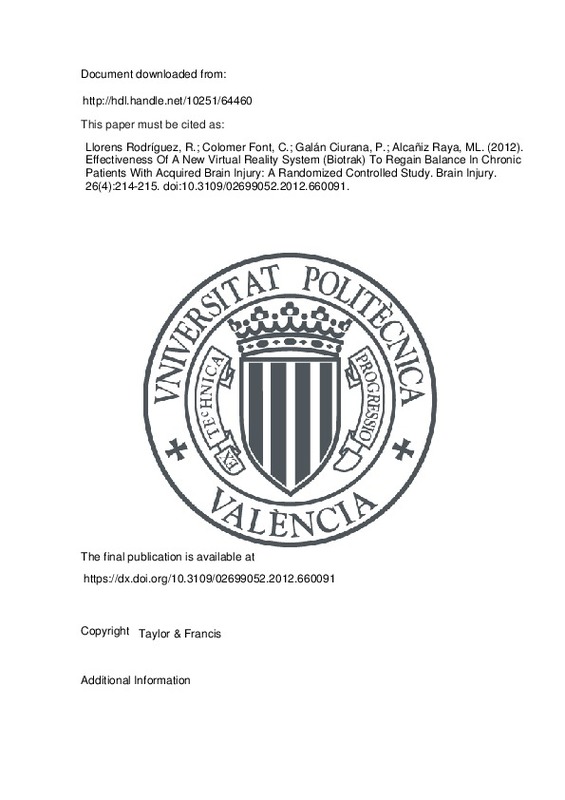Castellanos, N. P., Paúl, N., Ordóñez, V. E., Demuynck, O., Bajo, R., Campo, P., … Maestú, F. (2010). Reorganization of functional connectivity as a correlate of cognitive recovery in acquired brain injury. Brain, 133(8), 2365-2381. doi:10.1093/brain/awq174
Sherer, M., Nakase-Thompson, R., Yablon, S. A., & Gontkovsky, S. T. (2005). Multidimensional Assessment of Acute Confusion After Traumatic Brain Injury. Archives of Physical Medicine and Rehabilitation, 86(5), 896-904. doi:10.1016/j.apmr.2004.09.029
Sherer, M., Yablon, S. A., Nakase-Richardson, R., & Nick, T. G. (2008). Effect of Severity of Post-Traumatic Confusion and Its Constituent Symptoms on Outcome After Traumatic Brain Injury. Archives of Physical Medicine and Rehabilitation, 89(1), 42-47. doi:10.1016/j.apmr.2007.08.128
[+]
Castellanos, N. P., Paúl, N., Ordóñez, V. E., Demuynck, O., Bajo, R., Campo, P., … Maestú, F. (2010). Reorganization of functional connectivity as a correlate of cognitive recovery in acquired brain injury. Brain, 133(8), 2365-2381. doi:10.1093/brain/awq174
Sherer, M., Nakase-Thompson, R., Yablon, S. A., & Gontkovsky, S. T. (2005). Multidimensional Assessment of Acute Confusion After Traumatic Brain Injury. Archives of Physical Medicine and Rehabilitation, 86(5), 896-904. doi:10.1016/j.apmr.2004.09.029
Sherer, M., Yablon, S. A., Nakase-Richardson, R., & Nick, T. G. (2008). Effect of Severity of Post-Traumatic Confusion and Its Constituent Symptoms on Outcome After Traumatic Brain Injury. Archives of Physical Medicine and Rehabilitation, 89(1), 42-47. doi:10.1016/j.apmr.2007.08.128
Ayalon, L., Borodkin, K., Dishon, L., Kanety, H., & Dagan, Y. (2007). Circadian rhythm sleep disorders following mild traumatic brain injury. Neurology, 68(14), 1136-1140. doi:10.1212/01.wnl.0000258672.52836.30
Bushnik, T., Englander, J., & Katznelson, L. (2007). Fatigue after TBI: Association with neuroendocrine abnormalities. Brain Injury, 21(6), 559-566. doi:10.1080/02699050701426915
Clinchot, D. M., Bogner, J., Mysiw, W. J., Fugate, L., & Corrigan, J. (1998). DEFINING SLEEP DISTURBANCE AFTER BRAIN INJURY1. American Journal of Physical Medicine & Rehabilitation, 77(4), 291-295. doi:10.1097/00002060-199807000-00006
Glickman, G., Byrne, B., Pineda, C., Hauck, W. W., & Brainard, G. C. (2006). Light Therapy for Seasonal Affective Disorder with Blue Narrow-Band Light-Emitting Diodes (LEDs). Biological Psychiatry, 59(6), 502-507. doi:10.1016/j.biopsych.2005.07.006
Giacino, J. T., Kalmar, K., & Whyte, J. (2004). The JFK Coma Recovery Scale-Revised: Measurement characteristics and diagnostic utility11No commercial party having a direct financial interest in the results of the research supporting this article has or will confer a benefit upon the authors or upon any organization with which the authors are associated. Archives of Physical Medicine and Rehabilitation, 85(12), 2020-2029. doi:10.1016/j.apmr.2004.02.033
Schnakers, C., Perrin, F., Schabus, M., Majerus, S., Ledoux, D., Damas, P., … Laureys, S. (2008). Voluntary brain processing in disorders of consciousness. Neurology, 71(20), 1614-1620. doi:10.1212/01.wnl.0000334754.15330.69
Rohling, M. L., Binder, L. M., Demakis, G. J., Larrabee, G. J., Ploetz, D. M., & Langhinrichsen-Rohling, J. (2011). A Meta-Analysis of Neuropsychological Outcome After Mild Traumatic Brain Injury: Re-analyses and Reconsiderations of Binder et al. (1997), Frencham et al. (2005), and Pertab et al. (2009). The Clinical Neuropsychologist, 25(4), 608-623. doi:10.1080/13854046.2011.565076
Iverson, G. L. (2010). Mild traumatic brain injury meta-analyses can obscure individual differences. Brain Injury, 24(10), 1246-1255. doi:10.3109/02699052.2010.490513
Demertzi, A., Schnakers, C., Ledoux, D., Chatelle, C., Bruno, M.-A., Vanhaudenhuyse, A., … Laureys, S. (2009). Different beliefs about pain perception in the vegetative and minimally conscious states: a European survey of medical and paramedical professionals. Coma Science: Clinical and Ethical Implications, 329-338. doi:10.1016/s0079-6123(09)17722-1
[-]







![[Cerrado]](/themes/UPV/images/candado.png)


